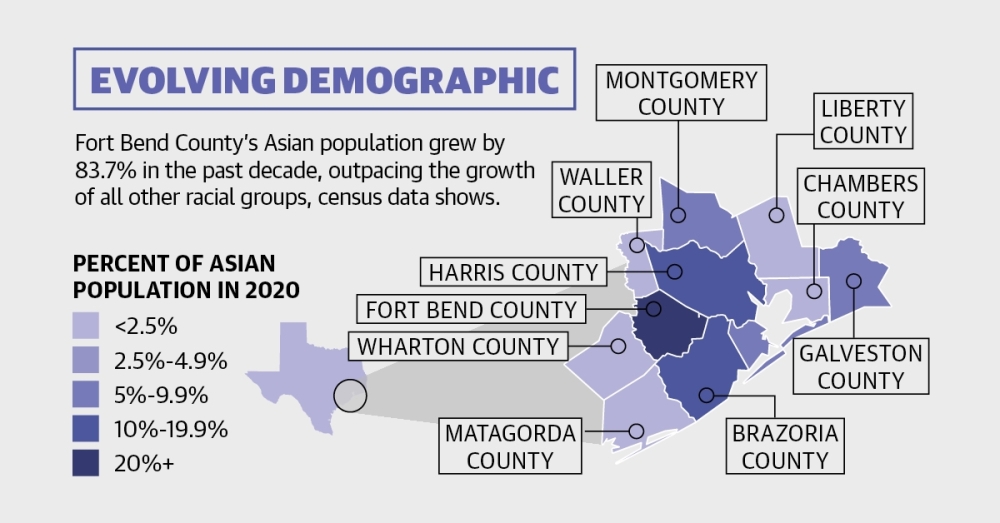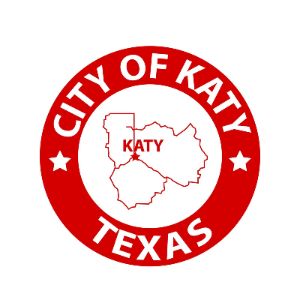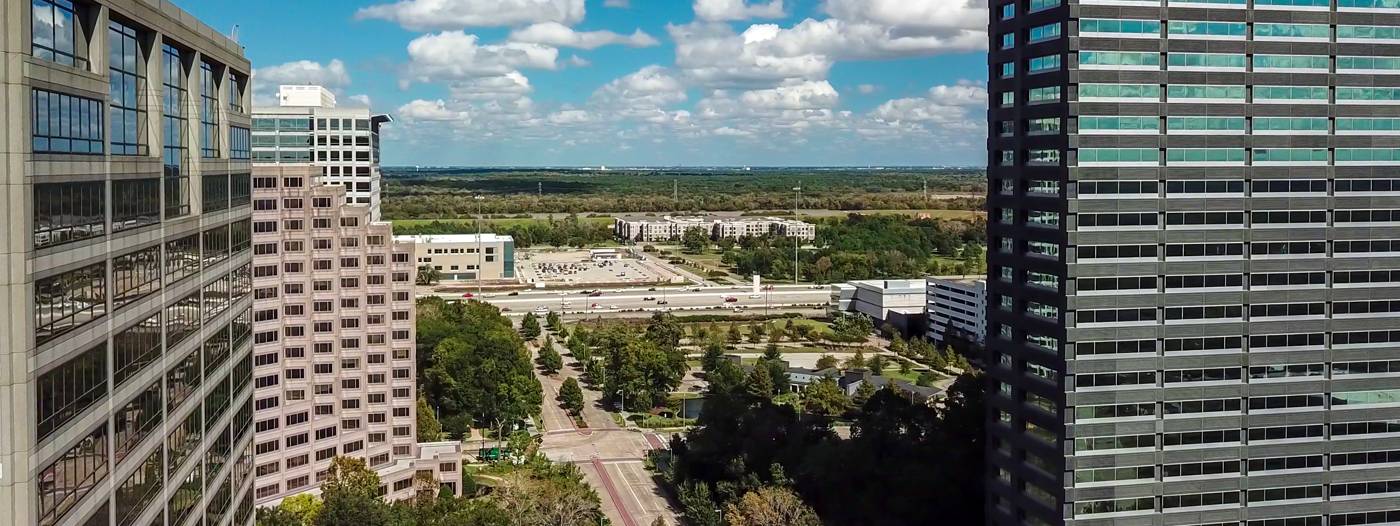Katy area, Fort Bend County see notable increase in Asian population, data shows

4 Oct 2021
By: Rynd Morgan - Community Impact
New census data shows the Asian population in Fort Bend County and in Katy has significantly increased in the past decade.
Local experts said this is driven by new construction in the area, desirable school districts and a growing number of businesses catering to the Asian community—as more than a dozen Asian-catering businesses have opened in the Katy area this year, according to new businesses confirmed by Community Impact Newspaper’s monthly reporting.
Fort Bend County has Texas’ highest proportion of Asian residents, according to the U.S. Census Bureau’s 2020 data released mid-August. The county’s Asian population made up 22.2% in 2020, compared to 7.4% in Harris County and 1.4% in Waller County.
The population of Fort Bend County’s Asian residents increased by 83.7% in the past 10 years, outpacing the growth of all other racial groups, according to the census data. Fort Bend County’s total population increased by 40.6%.
Pramod Sambidi, manager of socioeconomic modeling for the Houston-Galveston Area Council, said Fort Bend County is one of the most racially diverse counties in the U.S. Fort Bend County, specifically
Sugar Land and unincorporated areas of the county, experienced a significant increase in the share of Asian population over the past few decades, according to Sambidi.
“Asians prefer to move or relocate close to existing Asian communities,” Sambidi said.
The city of Katy saw similar growth in its Asian community, according to census data. The number of Asian residents in Katy nearly quadrupled, from 218 in 2010 to 867 in 2020, according to the census. Asians
now make up 4.3% of Katy’s population, compared to 1.55% in 2010.
Data also shows Asian individuals make up more than 20% of the residents in some portions of the Katy area, including south of the Katy Freeway and west of the Grand Parkway.
Salman Latif, a Realtor working in the Katy area, as well as in Fort Bend and Harris counties, said he has noticed an influx of people moving to the Fort Bend County and Katy areas from out of state, especially families from South Asian communities.
“It’s mainly the security, the safety, and then of course what it brings in community,” Latif said. “What mostly attracts is the ‘you’re far from home, but you’re still at home’ kind of feeling. Whatever language you speak, there’s people that speak that language.”
A growing community
Fort Bend County’s census data otherwise reflected national trends, including a decrease in residents identifying as only white, increases in other ethnic groups and overall population growth.
However, the growth of the Katy area’s Asian community distinguishes it from the rest of the state. This growth can be largely attributed to opportunities for residential expansion further west from Beltway 8, Sambidi said.
Katy Asian Town, a retail center at the intersection of I-10 and the Grand Parkway, opened in 2018 and is now home to many of the city’s Asian restaurants and businesses.
In 2019, the development expanded to include more retail space near the University of Houston-Victoria at Katy, said Josie Lin, owner of RE/MAX United and broker for Katy Asian Town.
The new retail space added to Katy Asian Town and the adjacent Katy Grand shopping development has increased inquiries from out-of-state buyers, Lin said. She said she believes that growth incentivized Asian-identifying buyers to come to Katy.
“The Katy Asian Town did bring more incentive for the Asian community from out of state to move in, because they can really enjoy the convenience,” Lin said. “They feel more comfortable after Katy Asian Town was built.”
Lance LaCour, president of the Katy Area Economic Development Council, said one of the greatest assets of the Katy area is its diverse population among both residents and businesses.
“Over the past several years, we have seen our Asian population continue to grow, and with that Asian-owned businesses have grown as well,” LaCour said. “Looking ahead, we anticipate continued growth and our organization stands ready to assist however possible.”
District demographics
Katy-area school districts have also attracted Asian buyers, with residential sales to Asian families increasing in the past few years, said Lin, who also sells residential properties.
“Katy always was an Asian destination for years, not only recently, because the new developments and new construction were very attractive, as well as, very important, the good school system,” Lin said.
“That’s one of the reasons why people have been flocking to Katy.”
Data for Katy ISD shows growth in its Asian population. KISD’s Asian student population grew from 11.1% in the 2011-12 school year to 16.1% in the 2020-21 school year. Lamar CISD showed overall
enrollment growth from 2011-12 to 2020-21, and the Asian student population grew from 5.4% to 7.2%. The number of Asian students enrolled grew from 1,366 to 2,637.
KISD spokesperson Laura Davis said the district is one of the fastest growing school districts in Texas, adding about 2,400 students each year.
“A variety of housing options, along with a strong economy, are two factors driving growth to the area,” Davis said.
Jason Le, a graduate of KISD’s Morton Ranch High School who now attends Hamilton College in upstate New York, said he missed the more diverse community in Katy after moving to New York.
“The times where I am home, I feel more comfortable there because of being able to see more [people of color and] being able to eat more diverse food,” Le said.
Le also said Katy Asian Town catalyzed growth in the Asian community, while attracting other communities.
“Everyone was going to H-Mart, everyone wanted boba, everyone wanted pho. ... And at that point I was like, ‘Wow, now I feel proud of being Asian,’ because it’s like, now everyone is celebrating Asian culture,” Le said.
Suburban growth
As the city of Sugar Land approached build-out and the home prices in the city increased, Asian individuals started looking for new neighborhoods within Fort Bend County. Many chose unincorporated areas around Katy, Fulshear, and Richmond, Sambidi said.
David Cheng, who owns Spring Green Family Dental with his wife, Vivian Tso, said he chose to open a business and raise a family in Katy because he grew up in the area and knew it was a family-oriented area with people of similar backgrounds.
“We’re open to anyone, but that’s our background, and Katy is known for being a family-oriented community,” Cheng said.
According to the Rice University Kinder Institute for Urban Research’s report, 2021 State of Housing in Harris County and Houston, families are increasingly moving to west Harris County. The study, which was released in June, showed the population in Houston becoming older and less diverse, with central Harris County following the trend.
“Katy is the west gateway of Houston,” Lin said. “This is very close to the west side of the city, to Austin and San Antonio, so it gives people more flexibility to access different areas.”
Jeffrey C. Wiley, president and CEO of the Fort Bend Economic Development Council, said the county’s diversity has contributed to its overall growth, helping make Fort Bend County the 16th fastest-growing county in the nation.
“We have seen an explosion of Asian-owned businesses—from large corporations to one-person small businesses—develop in Fort Bend County,” Wiley said. “This amalgamation of different cultures, businesses and ideas makes our community even stronger and more attractive to individuals and businesses as we continue to lean toward a population of 1 million people in the next few years.”
More Topics






